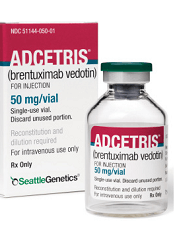
Photo from Business Wire
Five-year follow-up data from a phase 2 trial indicate that a subset of Hodgkin lymphoma (HL) patients who fail autologous stem cell transplant can achieve long-term disease control with single-agent brentuximab vedotin and may potentially be cured.
Thirty-three percent of patients in this trial achieved a complete remission (CR) with brentuximab vedotin, 13% remained in CR for more than 5 years, and 9% remained in CR without receiving a consolidative allogeneic transplant.
These results were published in Blood. The trial was sponsored by Seattle Genetics, Inc. and Takeda Pharmaceutical Company Limited, the companies developing brentuximab vedotin.
“At the time of trial initiation, historical outcomes for Hodgkin lymphoma patients who relapsed after an autologous stem cell transplant were poor, with median post-progression survival of 1.3 years, and the only long-term disease control option for these patients was considered to be an allogeneic stem cell transplant,” said study author Robert Chen, MD, of City of Hope National Medical Center in Duarte, California.
“The median survival of the patients on [brentuximab vedotin] monotherapy in this pivotal phase 2 trial exceeds these historic figures, and I am pleased to see the publication of the final data.”
Dr Chen previously reported results from this trial at the 2010 ASH Annual Meeting.
The single-arm trial, which supported the US approval of brentuximab vedotin in 2011, was conducted in 102 patients with relapsed or refractory classical HL. The patients’ median age was 31 (range, 15-77), they had an ECOG status of 0 or 1, and both genders were represented equally.
The patients had received a median of 3.5 chemotherapy regimens (range, 1-13), 66% had received prior radiation, and all patients had received an autologous transplant. Seventy-one percent of patients were refractory to frontline therapy, and 42% were refractory to their most recent treatment.
The patients received brentuximab vedotin intravenously at 1.8 mg/kg every 21 days for a maximum of 16 cycles.
Results
Thirty-four patients (33%) achieved a CR. At the 5-year follow-up and end of the study, the median duration of response was not reached.
Thirteen of the 34 patients (38%) who achieved a CR remained in remission at study closure. Of these patients, 4 underwent consolidative allogeneic stem cell transplants while in remission, and 9 received no further therapy.
Among the patients who achieved a CR, the estimated 5-year overall survival (OS) rate was 64%, and the estimated 5-year progression-free survival (PFS) rate was 52%.
For the entire study cohort, the median OS was 40.5 months, and the median PFS was 9.3 months. The estimated 5-year OS was 41%, and the estimated 5-year PFS was 22%.
The most common adverse events of any grade were peripheral sensory neuropathy, fatigue, nausea, neutropenia, and diarrhea.
Treatment-emergent peripheral neuropathy occurred in 56 patients (55%). Eighty-eight percent of these patients had an improvement in their symptoms, and 73% had complete resolution of peripheral neuropathy.


